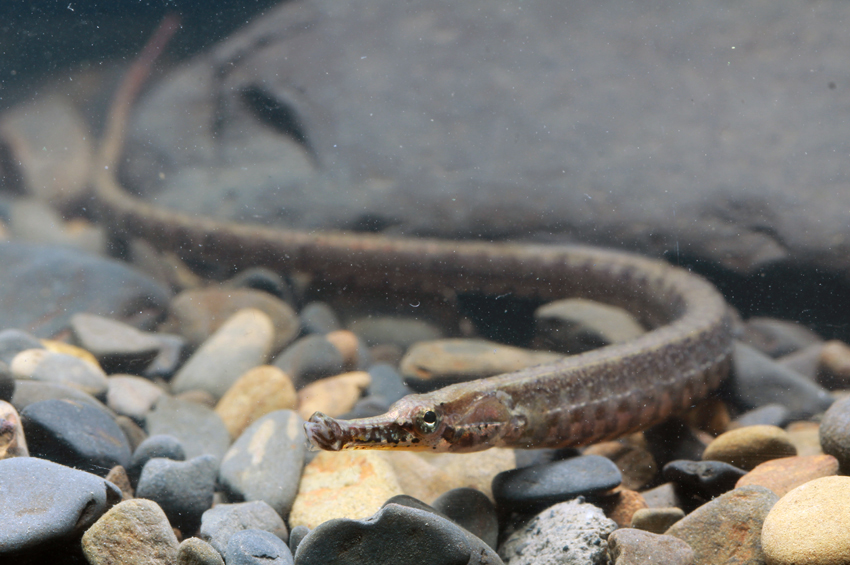Bellybar Pipefish, Hippichthys spicifer (Rüppell 1838)

A Bellybar Pipefish, Hippichthys spicifer, from Taiwan, ASIZP0072697. Source: Ta-Ching Chang / Fish Database of Taiwan, http://fishdb.sinica.edu.tw. License: CC by Attribution-NonCommercial-NoDerivatives
A mottled brownish to reddish pipefish becoming bluish below, with prominent dark bars across the lower part of the trunk. In some very dark adult pipefish, the bars are absent or obscured. This species lacks rows of distinct brown spots along the dorsal fin.
Bellybar Pipefish, Hippichthys spicifer (Rüppell 1838)
More Info
|
Distribution |
In Australia, the species is known from Cape York, Queensland. Elsewhere the species is widespread in the Indo-west Pacific from east Africa and the Red Sea, eastwards to Kiribati and American Samoa. The Bellybar Pipefish inhabits shallow coastal waters, including mangroves, tidal creeks and lower freshwater reaches of rivers and streams. |
|
Features |
Dorsal fin 25-30; Pectoral fin 15-18 (usually 17); Trunk rings 14-16; Total rings 36-41. Head length 6.9-10.3 in SL; snout moderately long, 1.8-2.1 in head length; snout depth 3.6-5.7 in snout length; median dorsal snout ridge low; keels typically present on some or most scutella; superior trunk and tail ridges discontinuous; inferior trunk and tail ridges continuous; lateral trunk ridge straight and not deflected ventrally near the anal ring. Dorsal fin origin usually on 2nd-3rd tail ring, fin base not elevated. |
|
Size |
To 180 mm TL. |
|
Colour |
Bellybar Pipefish are brownish to red dorsally, bluish ventrally, with.a fine mottling of brown blotches and small pale spots. The antero-ventral half of the body usually has a prominent series of brown to blue bars interspersed with yellow to white bars. The lower part of the head usually with black dots; no rows of distinct brown spots on dorsal-fin rays. |
|
Feeding |
Feeds on small planktonic crustaceans. |
|
Biology |
Male Bellybar Pipefish incubate the eggs in a well-defined brood pouch under the tail. The developing eggs are protected by fleshy bilateral pouch folds that meet along the ventral midline of the pouch to partly or fully enclose the pouch. Males may begin brooding at 98 mm SL. Eggs are oval and crowded in up to 10-11 transverse rows (typically in a single layer) across the upper part of pouch folds and dorsum of the pouch; not in a continuous gelatinous matrix but covered by protective folds which meet or overlap on ventral midline. The brood pouch of males in located below 12-22 tail rings, and one male had 90 eggs in a 20-ring pouch. Larvae hatch at a length of about one centimetre. Both eggs and larvae have been described (Ishihara & Tachihara, 2009). Dawson (1978) documented 39 males of this species of 91-170 mm standard length, carrying eggs in brood pouches below 12-22 tail rings. One male had 90 eggs in a 20-ring pouch |
|
Fisheries |
Bellybar pipefish are collected for sale in the aquarium industry. |
|
Conservation |
Marine listed under the Environment Protection and Biodiversity Conservation Act 1999 and subject to the Commonwealth Wildlife Protection (Regulation of Exports and Imports) Act 1982. |
|
Remarks |
Specimens from different geographic regions vary somewhat in morphology and further investigation may reveal that this variation represents a species complex. |
|
Etymology |
Hippichthys is from the Greek ippos meaning horse and ichthys for fish. |
|
Species Citation |
Syngnathus spicifer Rüppell 1838, Fische des Rothen Meeres 4: 143, Et Tor, Sinai coast, Egypt, Gulf of Suez, Red Sea. |
|
Author |
Thompson, V.J. & D.J. Bray 2016 |
Bellybar Pipefish, Hippichthys spicifer (Rüppell 1838)
References
Allen, G.R. 1991. Field guide to the freshwater fishes of New Guinea. Christensen Research Institute, Madang, Papua New Guinea.
Allen, G.R., S.H. Midgley & M. Allen. 2002. Field guide to the freshwater fishes of Australia. Western Australian Museum, Perth.
Dawson, C.E. 1978. Review of the Indo-Pacific fish genus Hippichthys (Syngnathidae). Proc. Biol. Soc. Wash. 91(1): 132-157.
Dawson, C.E. 1985. Indo-Pacific Pipefishes (Red Sea to the Americas). Gulf Coast Research Laboratory, Ocean Springs, Mississippi. 230 pp.
Fritzsche, R., Matsuura, K., Collette, B., Nelson, J., Dooley, J., Carpenter, K.E., Bartnick, S., Sorensen, M. & Morgan, S.K. 2012. Hippichthys spicifer. The IUCN Red List of Threatened Species 2012: e.T154855A719858. Downloaded on 18 November 2016.
Ishihara, T. & K. Tachihara. 2009. The maturity and breeding season of the bellybarred pipefish, Hippichthys spicifer, in Okinawa-jima Island rivers. Ichthyol. Res. 56: 388–393.
Kuiter, R.H. 2009. Seahorses and their relatives. Aquatic Photographics, Seaford, Australia, 278 pp.
Pogonoski, J.J., D.A. Pollard & J.R. Paxton. 2002. Conservation Overview and Action Plan for Australian Threatened and Potentially Threatened Marine and Estuarine Fishes. Environment Australia, Canberra. 375 pp.
Randall, J.E. 2005. Reef and Shore Fishes of the South Pacific. New Caledonia to Tahiti and the Pitcairn Islands. University of Hawaii Press, Honolulu, Hawaii.
Rüppell, W.P.E. 1838. Neue Wirbelthiere zu der Fauna von Abyssinien gehörig. Fische des Rothen Meeres. Frankfurt Vol. 4: 81-148.






